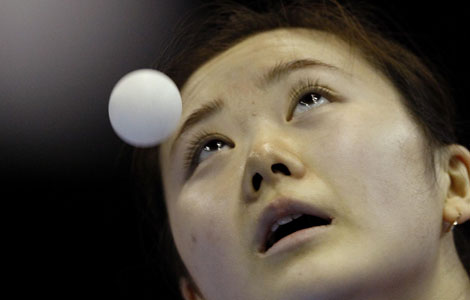RRR cut: China's monetary fine tuning
Updated: 2011-12-05 14:48
(Xinhua)
|
|||||||||
BEIJING - China's central bank cut the Reserve Requirement Ratio (RRR) for banks on Nov 30 by 50 basis points for the first time in nearly three years to ease credit strains and shore up economy as white-hot inflation is contained.
Analysts said the move, implying a fine tuning of macro policy, will contribute to keeping the stable and relatively fast economic growth in the current complex situation, however it does not mean the change will bring about a full-on move toward a looser monetary policy.
Injecting liquidity to keep growth
In order to replenish liquidity in the country's banking system, the country's central bank said it will reduce the ratio of money that banks have to set aside on deposit by 50 basis points among commercial lenders, effective on Dec 5. Analysts expected the cut to inject 350 to 400 billion yuan RMB ($55 to 63 billion) into the market.
"While facing volatile external demands and both eased economic growth and inflations, the RRR cut is a signal for stabilizing growth, making the central bank's fine-tuning of the country's monetary policy more explicit," said Zhuang Jian, a senior economist with the Asia Development Bank.
Zhou Jingtong, senior analyst of Bank of China, said the cut is expected as RRR is the prime choice when the central bank makes fine-tuning of monetary policy.
Zhou cited three reasons lie behind the move: first, China is under great pressure to keep economic growth. Externally, Europe and the United States are struggling for recovery from the global financial crisis and its aftermath; many emerging countries are faced with high inflation pressure. Domestically, the slowdown of exports and drop of Purchasing Managers' Index (PMI) have made injecting liquidity a necessity to keep economic growth.
Second, China's high inflation has eased. The Consumer Price Index (CPI) increased 5.5 percent in October, dropping from a 37-month high of 6.5 percent in July. The Bank of China estimated that November's CPI will drop to below 5 percent and to below 4 percent in December.
Third, many cash-trapped enterprises urgently need capital injection to keep running at the lowest level or manage some kind of expansion.
"If to keep growth has made it necessary to fine tune economic policy, then the drop of consumer prices has made it possible to do so," said Zhou, adding the two sides have combined to set a micro-adjustment pattern for China’s monetary policy.
Echoing Zhou's opinion, Ma Jun, chief economist at Deutsche Bank Greater China, said that the cut "falls within expectations." The current liquidity in the Chinese banking system has become too tight and the liquidity shortage has forced the central bank to inject money into the market.
China has increased the reserve ratio 12 times since 2010 to soak up liquidity and curb inflation, including six times in the first half of this year.
Lian Ping, chief economist at the Bank of Communications, gave his view that the reduced RRR rate will ease banks' credit crunch caused by a high RRR and decreased yuan funds from foreign exchanges, as well as promote reasonable growth in banking loans and stabilize economic growth.
The country's yuan funds stemming from foreign exchanges dropped in October on a month-on-month basis for the first time in nearly four years, according to the central bank.
"While facing volatile external demands and both eased economic growth and inflations, the RRR cut is a signal for stabilizing growth, making the central bank's fine-tuning of the country's monetary policy more explicit," said Zhuang Jian, a senior economist with the Asia Development Bank.
Data indicated that there is an increasing risk of slowdown of economic growth. China's economic growth slowed to a two-year low of 9.1 percent in the third quarter this year, down from 9.7 percent and 9.5 percent in the first quarter and the second quarter, respectively.
According to the China Federation of Logistics and Purchasing, China's PMI, a main gauge of manufacturing activity, tumbled to 49 in November from 50.4 in October, a fresh sign of a further economic slowdown.
A PMI under 50 indicates a contraction of manufacturing activity -- a situation that hasn't been seen since February 2009.
China's efforts to restructure its economic growth pattern, anti-inflation fight and policies to ease the runaway property prices have weighed on growth. In addition, as the European sovereign debt crisis is still spreading, which has made China's export market experience the most difficult time since the Second World War. Consequently, the country's exports have registered negative growth for two consecutive months since September.
Sun Lijian, professor from Fudan University, is of the opinion that against the background of dropping yuan funds stemming from foreign exchanges, easing inflation pressure, decreasing RMB appreciation pressure and increasing risk of underground lending, the central bank wants to grasp this opportunity to cut the RRR rate so as to release liquidity.
Pudent policy not to change
Experts take cautious attitude as to whether the central bank's move means a fundamental change of China's monetary policy.
Guo Tianyong, director of the China Banking Research Centerat the Central University of Finance and Economics, said that the moves should not be seen asfundamental a change in China's current monetary policy stance.
The government should maintain a prudent monetary policy, as consumer prices are still at high levels and the country still needs to contain its red-hot property market, Guo said.
"The RRR cut is merely part of ongoing fine-tuning, which has been taking place since early October," wrote Lu Ting and three other researchers in BoAML's report.
Tian Yuan, a macroeconomics analyst at Bank of America Merrill Lynch, said the move doesn't necessarily mean that the People's Bank of China will change the direction of its monetary policy, adding that liquidity is still ample in society as a whole, and loosening monetary policies too much threatens to fuel inflation, which has just slightly eased.
Ba Shusong, an economist with the Development Research Center under China's State Council, said lowering RRR rate signified a fine tuning of macro policy rather than a complete change of the tone.
"With monetary condition remains relax globally, the future trend of commodity prices is still uncertain, the basis of stabilizing prices is not solid yet," Ba said.
"We expected that the CPI would rise by 3.5 percent to 4 percent next year, which is not a low level, so we still need to stick to prudent monetary policy," Ba added.
A central bank report concerning monetary policies implemented in the third quarter said the country will closely monitor the changes in economic and financial situations both domestically and globally, and preset or fine tune the policies when needed.
The report said the central bank will continue to maintain the current prudent monetary policies while making them more targeted and flexible.
Analysts held that the RRR cut does not mean the loosening the macro control policies in the real estate sector, and will not stem the current decline in real estate prices.
They said that lowering the reserve ratio won't have an impact on the country's property market, "The banks are simply not allowed to lend to developers. It's not about how much money they have."
The RRR cut, although good news, is not significant enough to help fund-strapped real estate developers, said Xu Chuangming, head of the market research department of Hopefluent Group Holdings Ltd, a real estate consulting firm.
Many developers are experiencing hard times, as both sales and prices have fallen in wake of a slew of government measures, including higher lending rates, purchasing limits and a ban on mortgage loans on third homes, that were aimed at taming the once red-hot sector.











